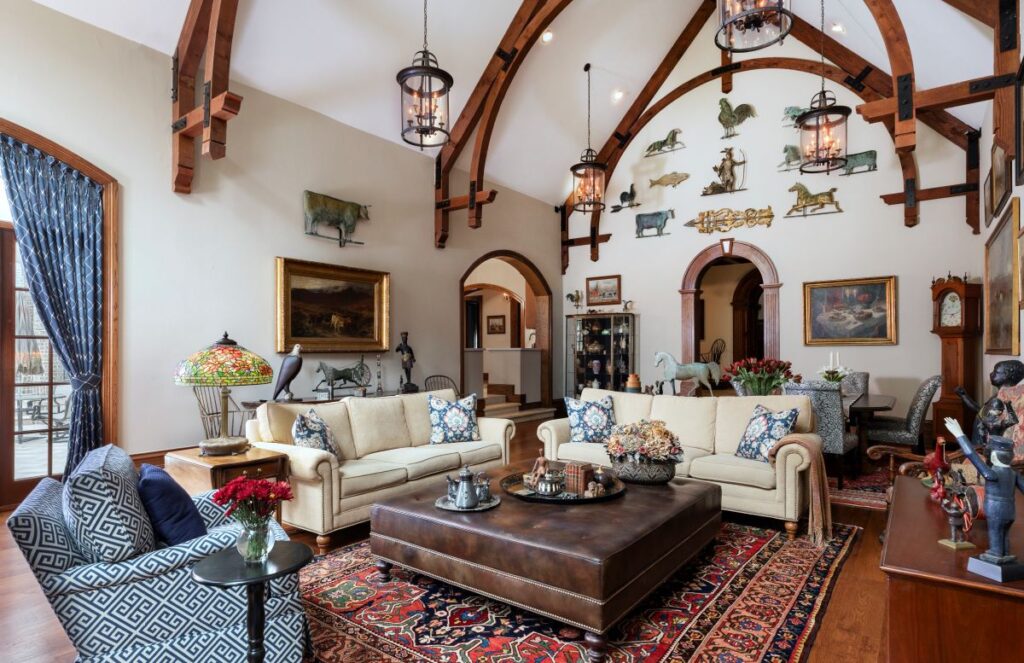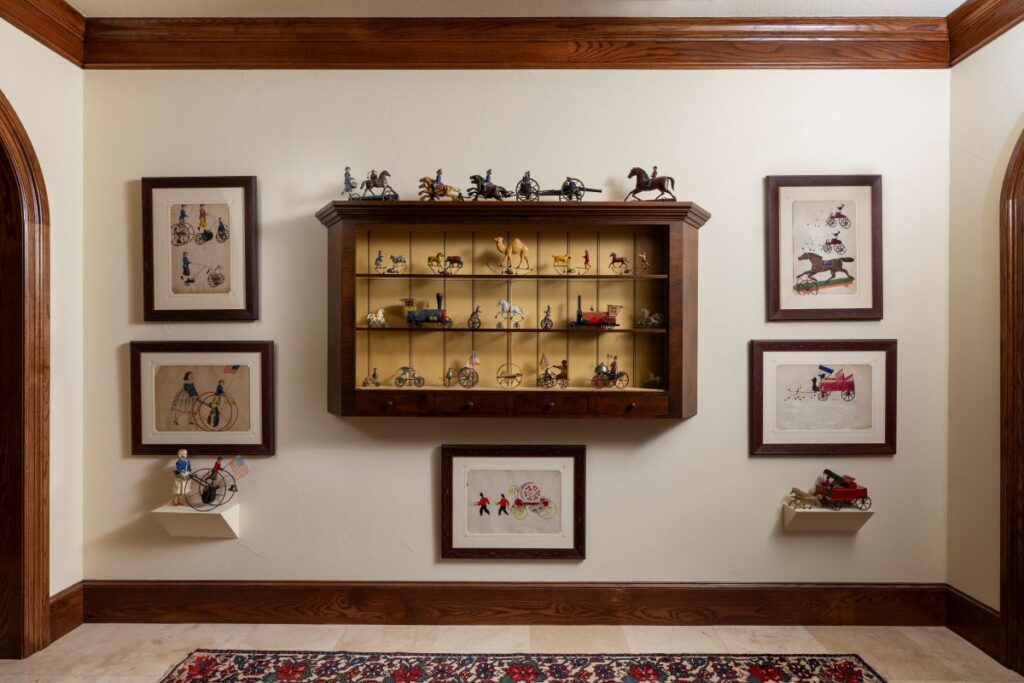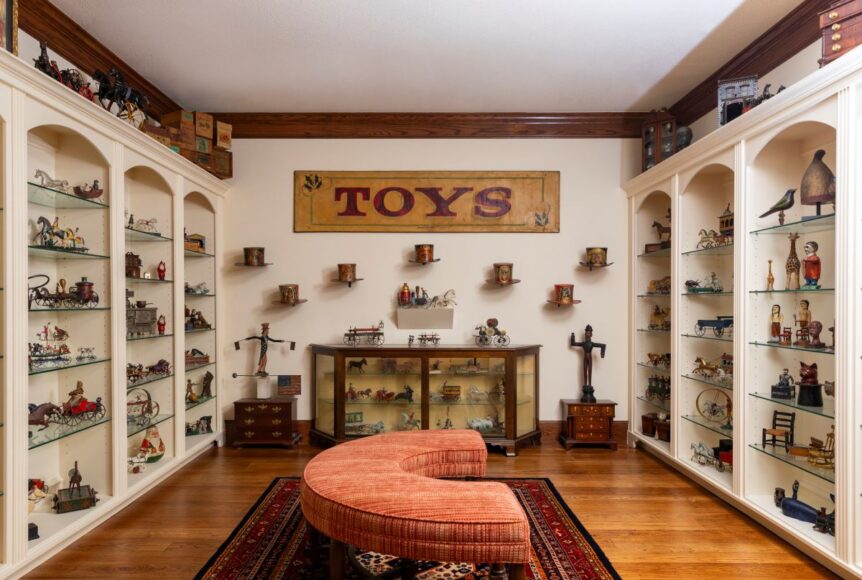
Among connoisseurs of American folk art and collectibles, great private holdings rarely remain secret, even when their owners prefer anonymity. That’s certainly true for the Houston-area folk art enthusiast who opened his doors to The Magazine ANTIQUES this past fall. For decades, this CEO and entrepreneur has been a major player in the close-knit world of antiques—on a first name basis with top dealers, directors of auction houses, and fellow buyers who sometimes offer him private sale rarities. At his suburban home, where custom-built cases display hundreds of objects, the collector and his wife often have welcomed groups of folk art insiders. And, for decades, they have been prominent supporters of the American Folk Art Museum in New York.
Still, this Houston native prefers to keep the focus on his collection—not his name—and, why not, when the collection is so remarkable? It centers on a trove of some three hundred tin and cast-metal toys from the nineteenth century, and has grown, over the past forty years, to include mechanical banks, cigar store Indians, painted wood barber poles, a carousel horse head, the decorative helmets worn by parading firemen, and dozens of weathervanes posted high on the walls of a lofty, two-story living room (Fig. 6). Equally eye-catching is the profusion of well-documented folk paintings, which includes work by such named artists as Samuel and Ruth Shute, John Rasmussen, Deborah Goldsmith, and Grandma Moses. In recent years, this Houston collector has cast his net even wider, assembling one of the nation’s best private collections of carved wood Eastern Woodlands Indian artifacts (Figs. 11, 12).






Although furniture and functional domestic objects have been of secondary interest for the Texan, his house is sprinkled with handsome period pieces—a fireman’s painted equipment storage chest, several Gothic revival cabinets, a Pennsylvania Soap Hollow dresser, scrimshaw carvings, a New York State blanket chest, a Tiffany lamp, and a tramp art bureau made for the tabletop. Taken together, those pieces provide context for a collection that powerfully evokes the mood and manners of nineteenth-century America—a nation of steamships, railroads and horses, of patriotic festivals and Reconstruction conflicts, of fraternal orders and firemen’s parades, of industrial progress, and the pathos of low life expectancy among children.
“I started as a coin collector at age fourteen, and I quickly learned the first rule of the game: if you’re going to live with things, buy what you like. It’s trite, but true,” the Texan says. “I also learned a few things when I used the coin shop’s consignment bid board—which was kind of like a silent auction for the shop’s customers. I saw that collecting was a form of entertainment, a way to meet like-minded people. I also learned not to underprice my pieces after a dealer came into the shop and snapped up my coins immediately. I haven’t forgotten that as a collector—or in my business career. I always ask: did you get a good price or the best price? Did you do enough research?”
The collector’s passion for research came through when he showed me a personal library of scholarly books and auction catalogues he has acquired over a half-century of bidding. Again and again, he pointed to documented examples of works that have entered his collection, many coming from fabled collections that helped establish the modern taste for American folk art, including those of Bernard Barenholtz, Ralph Esmerian, and singer Andy Williams.
“As a collector, you need to read and you need to look, but you also need to listen,” he says. “That’s why I also have formed relationships with trusted dealers and auction houses in the Northeast, where so much work comes to market.”





Among those dealers, he was quick to single out Steven S. Powers, a past president of the Antiques Dealers’ Association of America, who helped him gather his Eastern Woodlands Indian collection, among other things. The Texan also mentioned his decades-long friendship with Jeanne Bertoia, who helped expand the market for antique toys at Bertoia Auctions; and he talked about his relationship with Steven Weiss of Gemini Antiques and RSL Auction Company, describing him as “the kind of dealer who notices when you raise a paddle at auction, finds a seat next to you, and starts trading information.”

Powers has been especially close with the collector, often flying to Texas to discuss individual pieces and the scope of the collection. Powers says: “He’s very impressed with craftsmanship, and looks to see how things are made. He understands that ‘folk’ doesn’t mean naive or shoddy just because the maker wasn’t formally trained. He has a discerning eye and loves to handle pieces—and I think some of that comes from his business, which involves precision products for the oil and gas industry. He gets his hands in and gets dirty. He doesn’t just buy impulsively.”
Powers has watched the collector’s taste evolve over the past fifteen years: “I saw him respond to the sensuality of hand-carved burl bowls and ladles, something that requires touch, not just looking. And he understands that these Woodlands Indian pieces were more than utilitarian. For their original owners, these effigy ladles were personal totems, often used on ceremonial occasions, with their imagery drawn from dreams.”
The collector’s attention to the deeper, spiritual resonance of material culture came through forcefully when he spoke about one of the twentieth-century outliers in his collection: the Psalm 23 quilt, wrought by Lena Moore about 1930, in Canton, Mississippi (Figs. 23a, 23b). With its edge-to-edge jumble of red letters on a white cotton ground, the piece could easily fit into a collection of contemporary paintings. The quilt’s graphic power won it a coveted position on the cover of Folk Art magazine in 2004. Still, the Texas collector didn’t talk about any of that. He kept it simple: “My wife and I are people of faith,” he says. “We responded to the message of the psalm.”







Throughout the collection, the quality of the objects is stunning. In the collector’s vast toy display we saw a pristine, unchipped example of a stamped-tin Harwood Patent Horse Toy from about 1875—a plaything that Bernard Barenholtz, in his book American Antique Toys, called the “most graceful of all American tin toys” (Fig. 13). Nearby, the collector showed us one of the earliest commercial toys made in this country: a Taylor Boat, from the 1840s, which was stenciled with the name of America’s twelfth president.
Among the paintings in the collection is John Rasmussen’s luminous, crisply rendered View of the Buildings and Surroundings of the Berks County Almshouse, made in the 1880s (Fig. 10). It had been one of the signature pieces in the Andy Williams collection.
The Texas collector also struck gold at an auction of material from the Esmerian collection, where he bought a hickory ship captain’s cane, topped with a freestanding figure, with details that include a top hat, frock coat, pressed trousers, cane, and crossed arms—all carved from one piece of wood.





One of the strengths of the collection is the way separate objects buttress each other. The Native American woodwork is displayed in a home office filled with mementos and trophies from the collector’s life as an outdoorsman (Fig. 12). Toy pumpers, ladder wagons, and hose reels are displayed alongside ceremonial parading hats worn by nineteenth-century firefighters. Play- things from Connecticut manufacturer George W. Brown are paired with whimsical watercolor drawings of the same toys, which came from the original designer’s sketchbook (Fig. 14).
The way the collector displays the pieces never overwhelms the comfortable, lived-in feeling of the house. It’s a place for relaxing, just the right size for a couple with grandchildren nearby. And it also provides an immaculate showcase for museum-quality objects. At home, the collector puts aside the business world, and lights and installs each work personally, climbing ladders and pounding nails. To get things right, he often uses an architect’s scale to draw plans for his displays. “I never buy anything without knowing where it will go,” he says. “It has to fit my standards and my walls.”

